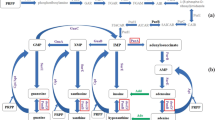Abstract
Penetration of pefloxacin into the uroepithelium was studied in 20 patients (10 men and 10 women) receiving a single oral dose of 800 mg. Samples of serum, urine, and uroepithelium were taken 1.8 h (mean) after the dose. Pefloxacin and its active metabolite, norfloxacin, were assayed by liquid chromatography, and the microbiologically active compounds were quantified by a microbiological assay. Both procedures were correlated (r>0.7); nevertheless, slight differences detected in concentrations depended on the levels of norfloxacin achieved in the biological samples. The serum and tissue concentrations were higher than the concentration of bactericide (4 μg·ml−1), except in one case. The uroepithelium concentration of pefloxacin was proportional to the serum concentration (r=0.79). The urinary concentrations ranged from 1.2 μg·ml−1 to 82.4 μg·ml−1. The mean norfloxacin/pefloxacin ratios were 3% in serum, 8% in uroepithelium, and 44% in urine. The mean uroepithelium/serum concentration ratios were 1 for pefloxacin and 2.3 for norfloxacin. This result shows that, at a time close to that of the maximum concentration, there is good penetration of pefloxacin and norfloxacin into the uroepithelium.
Similar content being viewed by others
References
Gonzales JP, Henwood JM (1989) Pefloxacin. A review of its antibacterial activity, pharmacokinetic properties and thepapeutic use. Drugs 37:628–668
Wolfson JS, Hooper DC, Swartz MN (1989) Mechanisms of action and resistance to quinolone antimicrobial agents. In: Wolfson JS, Hooper DC, (eds) Quinolone antimicrobial agents. AFM Washington DC, pp 5–34
Brykier A, Veyssier, Kazmierzcak A (1994) Fluoroquinolones: propriétés physicochimiques et microbiologiques. In: Encycl Méd Chir (Maladies Infectieuses) Ed. Techniques, Paris, 8–004-B-10, pp 1–12
Montay G, Jacquot C, Bariety J, Cunci R (1985) Pharmacokinetics of pefloxacin in renal insufficiency. Eur J Clin Pharmacol 29:345–349
Barré J, Houin G, Tillement JP (1984) Dose-dependent pharmacokinetic study of pefloxacin, a new antibacterial agent, in humans. J Pharm Sci 73:1379–1382
Griggs DJ, Wise R (1989) A simple isocratic high-pressure liquid chromatographic assay of quinolones in serum. J Antimicrob Chemother 24:437–445
Montay G, Tassel JP (1985) Improved high-performance liquid chromatographic determination of pefloxacin and its metabolite norfloxacin in human plasma and tissue. J Chromatogr 339:214–218
Costa P, Galtier M, Laurelli JM, Nivard G, Louis JF, Favier M, Hansel S, Navratil H, Grasset D (1989) Epididymites aiguës et antibiothérapie. Mesure de la diffusion epididymaire de la péfloxacine. J Urol (Paris) 95:41–44
Johnson RA, Wicher DW (1982) In: Prentice-Hall (ed) Applied multivariate statistical analysis, part III, Chap. 8. Englewood Cliffs, New Jersey, pp. 359–400
Webberley JM, Andrews JM, Ashby JP, McLeod A, Wise R (1987) Pharmacokinetics and tissue penetration of orally administered pefloxacin. Eur J Clin Microbiol 6:521–524
Cardey J, Silvain C, Bouquet S, Breux JP, Becq-Giraudon B, Fourtillan JB, Beauchant M (1987) Oral pharmacokinetics and ascitic fluid penetration of pefloxacin in cirrhosis. Eur J Clin Pharmacol 33:469–472
Brion N, Lassana A, Mosset F, Lefevre JJ, Montay G (1986) Penetration of pefloxacin in human heart valves. J Antimicrob Chemother 17 [Suppl B]:89–92
Menozzi MG, Larini S, Chezzi C, Santini R, Simonazzi M, Bezzi E (1987) Blood, urine and urogenital tract tissue concentrations of norfloxacin (Sebercim*) after single oral dose in human patients. Clin Trials J 24:275–283
Jack DB, Fuentes Gonzales J, Laugher SJ (1986) The rapid measurement of distribution coefficient of 4-quinolones by reversed-phase thin-layer chromatography. International Symposium on new quinolones, Geneva, Switzerland. Abstract
Pangon B, Gehanno P, Daldoss C, Legrand P (1983) Tissue diffusion of pefloxacin: study in man. In: Spitzy KM, Karrer K (eds) Thirteenth International Congress of Chemotherapy. Vienna, part 110, pp 29–31
Author information
Authors and Affiliations
Rights and permissions
About this article
Cite this article
Moreau, J.L., Royer-Morrot, M.J., Royer, R.J. et al. Penetration of pefloxacin and its desmethyl metabolite into the uroepithelium after a 800-MG single oral dose in human patients. Eur J Clin Pharmacol 49, 401–405 (1996). https://doi.org/10.1007/BF00203786
Received:
Accepted:
Issue Date:
DOI: https://doi.org/10.1007/BF00203786




